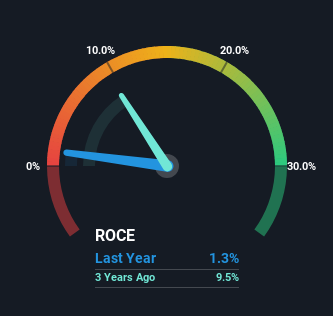Investors Could Be Concerned With Jiangsu Xinri E-Vehicle's (SHSE:603787) Returns On Capital
What are the early trends we should look for to identify a stock that could multiply in value over the long term? Firstly, we'll want to see a proven return on capital employed (ROCE) that is increasing, and secondly, an expanding base of capital employed. Put simply, these types of businesses are compounding machines, meaning they are continually reinvesting their earnings at ever-higher rates of return. However, after investigating Jiangsu Xinri E-Vehicle (SHSE:603787), we don't think it's current trends fit the mold of a multi-bagger.
Understanding Return On Capital Employed (ROCE)
For those that aren't sure what ROCE is, it measures the amount of pre-tax profits a company can generate from the capital employed in its business. To calculate this metric for Jiangsu Xinri E-Vehicle, this is the formula:
Return on Capital Employed = Earnings Before Interest and Tax (EBIT) ÷ (Total Assets - Current Liabilities)
0.013 = CN¥20m ÷ (CN¥3.5b - CN¥1.9b) (Based on the trailing twelve months to March 2024).
Thus, Jiangsu Xinri E-Vehicle has an ROCE of 1.3%. In absolute terms, that's a low return and it also under-performs the Auto industry average of 2.9%.
Check out our latest analysis for Jiangsu Xinri E-Vehicle

While the past is not representative of the future, it can be helpful to know how a company has performed historically, which is why we have this chart above. If you want to delve into the historical earnings , check out these free graphs detailing revenue and cash flow performance of Jiangsu Xinri E-Vehicle.
So How Is Jiangsu Xinri E-Vehicle's ROCE Trending?
We weren't thrilled with the trend because Jiangsu Xinri E-Vehicle's ROCE has reduced by 78% over the last five years, while the business employed 62% more capital. However, some of the increase in capital employed could be attributed to the recent capital raising that's been completed prior to their latest reporting period, so keep that in mind when looking at the ROCE decrease. It's unlikely that all of the funds raised have been put to work yet, so as a consequence Jiangsu Xinri E-Vehicle might not have received a full period of earnings contribution from it.
On a side note, Jiangsu Xinri E-Vehicle's current liabilities have increased over the last five years to 54% of total assets, effectively distorting the ROCE to some degree. If current liabilities hadn't increased as much as they did, the ROCE could actually be even lower. And with current liabilities at these levels, suppliers or short-term creditors are effectively funding a large part of the business, which can introduce some risks.
In Conclusion...
In summary, we're somewhat concerned by Jiangsu Xinri E-Vehicle's diminishing returns on increasing amounts of capital. Long term shareholders who've owned the stock over the last five years have experienced a 31% depreciation in their investment, so it appears the market might not like these trends either. That being the case, unless the underlying trends revert to a more positive trajectory, we'd consider looking elsewhere.
On a separate note, we've found 2 warning signs for Jiangsu Xinri E-Vehicle you'll probably want to know about.
For those who like to invest in solid companies, check out this free list of companies with solid balance sheets and high returns on equity.
New: Manage All Your Stock Portfolios in One Place
We've created the ultimate portfolio companion for stock investors, and it's free.
• Connect an unlimited number of Portfolios and see your total in one currency
• Be alerted to new Warning Signs or Risks via email or mobile
• Track the Fair Value of your stocks
Have feedback on this article? Concerned about the content? Get in touch with us directly. Alternatively, email editorial-team (at) simplywallst.com.
This article by Simply Wall St is general in nature. We provide commentary based on historical data and analyst forecasts only using an unbiased methodology and our articles are not intended to be financial advice. It does not constitute a recommendation to buy or sell any stock, and does not take account of your objectives, or your financial situation. We aim to bring you long-term focused analysis driven by fundamental data. Note that our analysis may not factor in the latest price-sensitive company announcements or qualitative material. Simply Wall St has no position in any stocks mentioned.
Have feedback on this article? Concerned about the content? Get in touch with us directly. Alternatively, email editorial-team@simplywallst.com
About SHSE:603787
Jiangsu Xinri E-Vehicle
Researches, develops, manufactures, and sells electric vehicles in China and internationally.
Excellent balance sheet second-rate dividend payer.
Market Insights
Community Narratives



